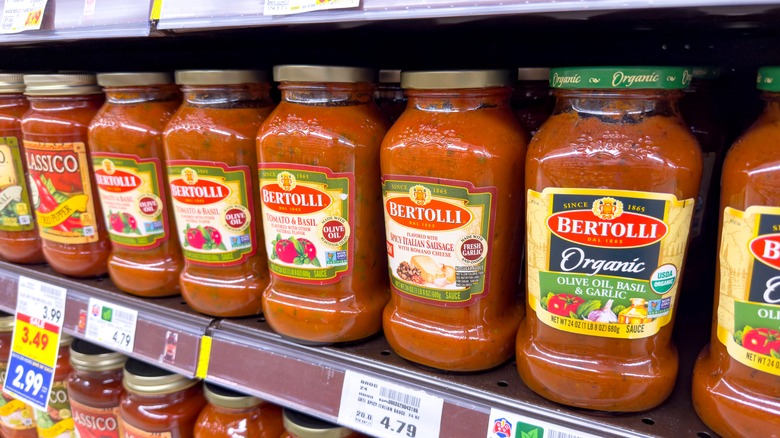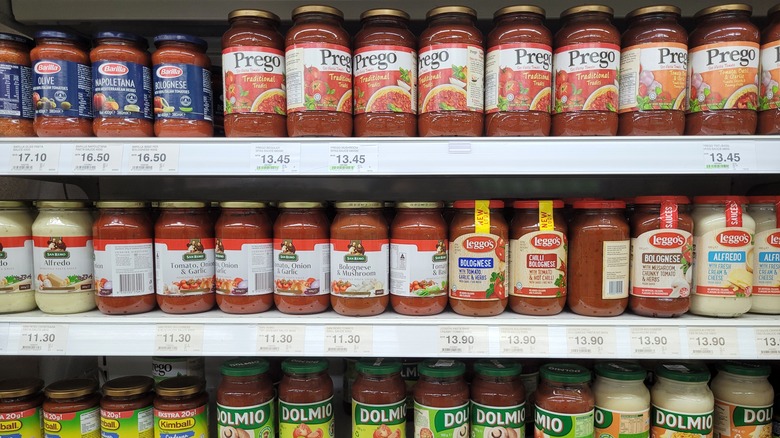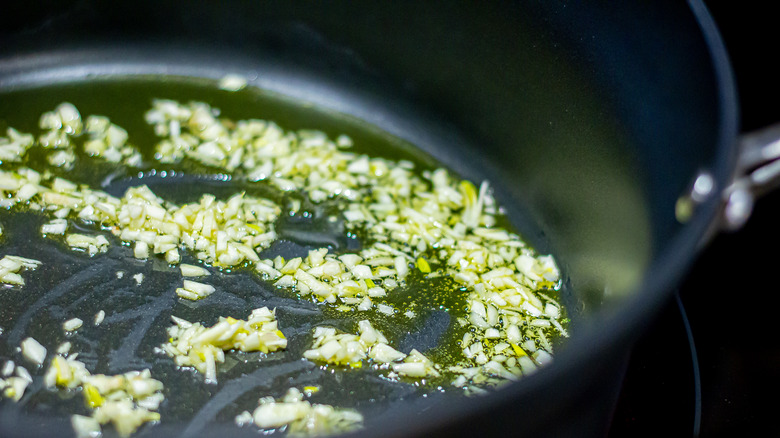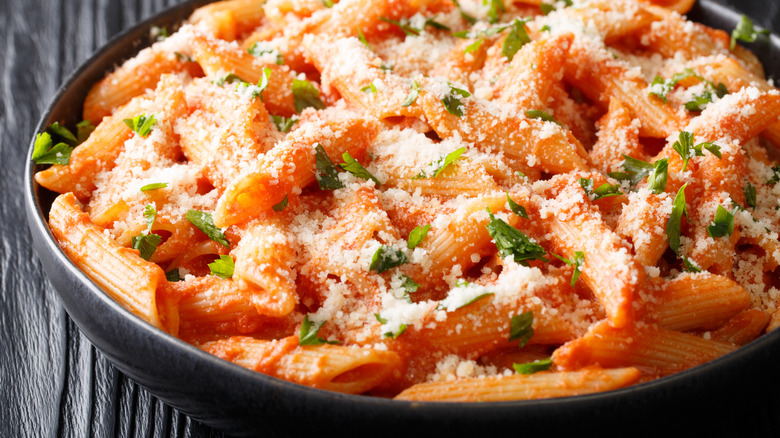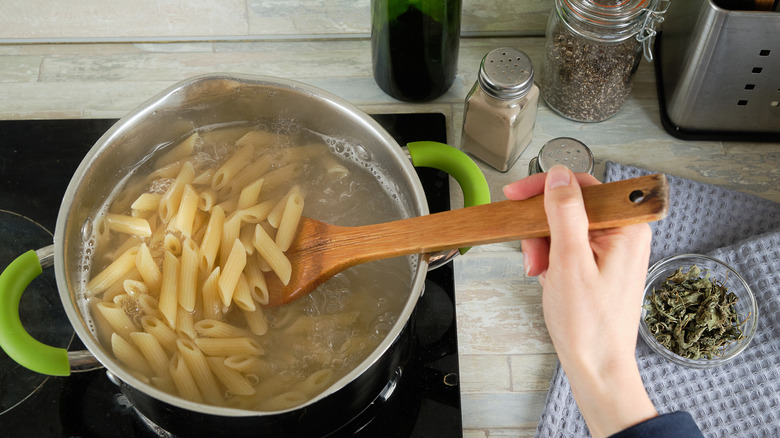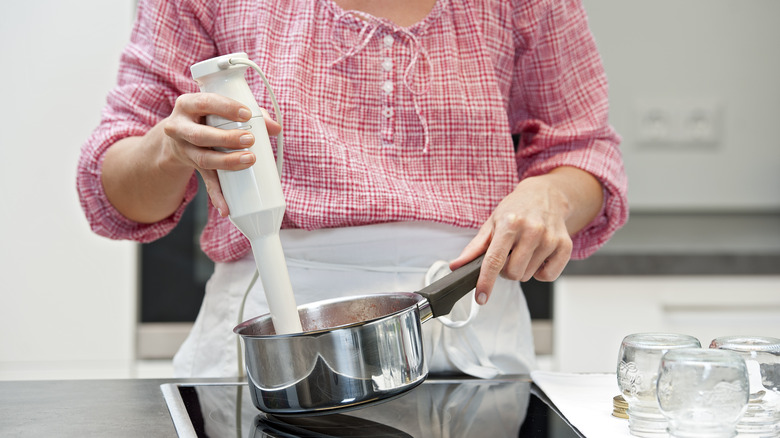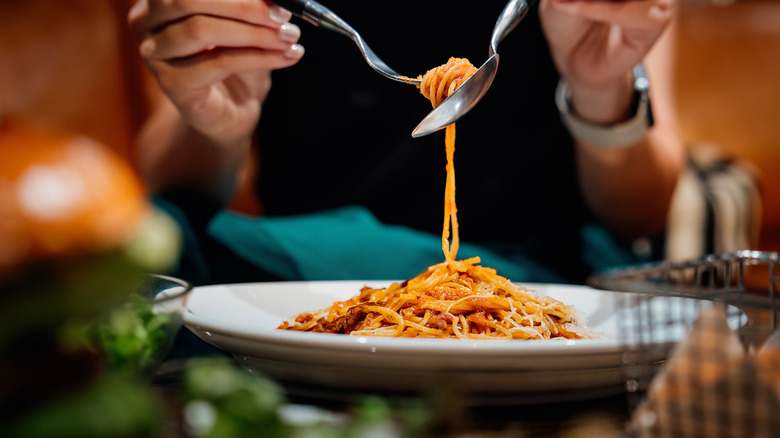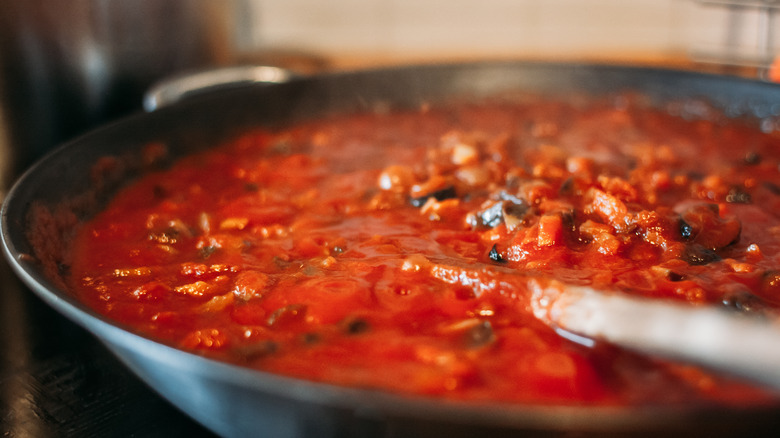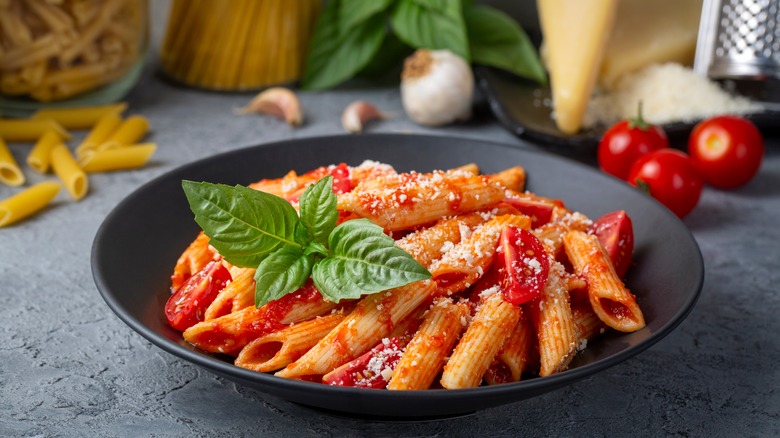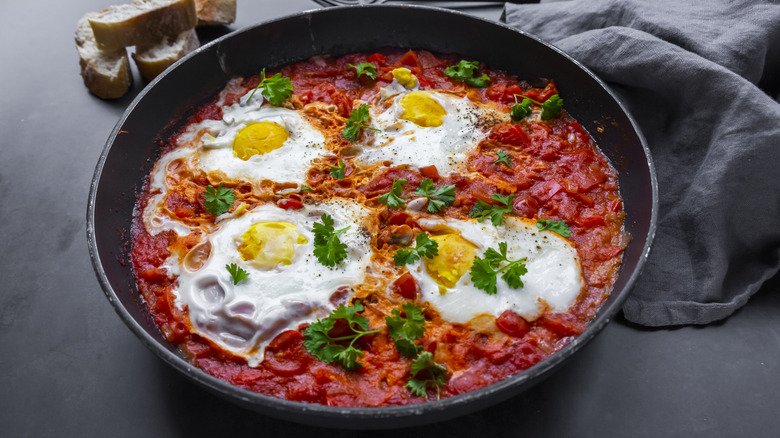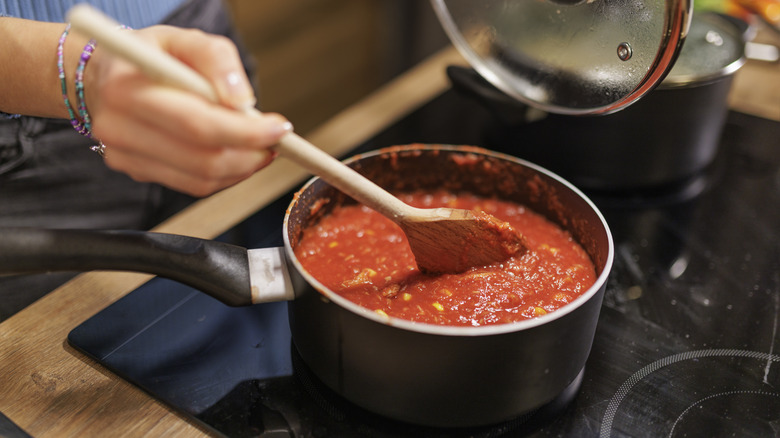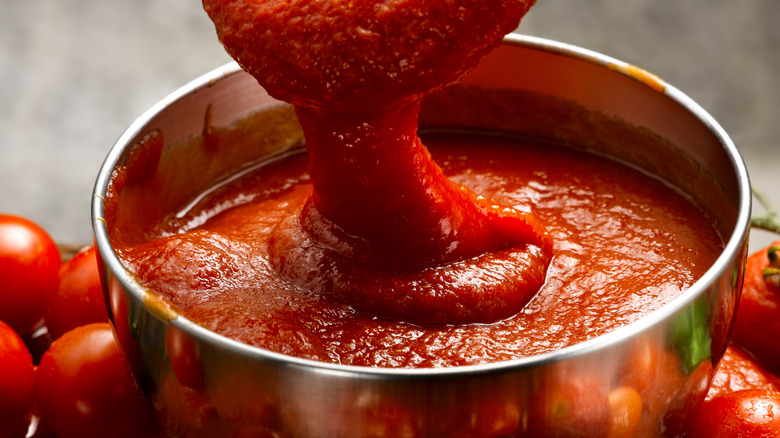12 Tricks To Make Jarred Pasta Sauce Taste Homemade, According To Chefs
If you have experience both making homemade pasta sauce from scratch, at home, and buying the jarred or canned stuff from the store, you know that the two can be worlds apart. On one hand, you have a rich, thick, flavorful sauce that's slow-simmered from fresh ingredients, filling your home with the aroma of tomatoes, garlic, and herbs. On the other, you have a bland jar of something that's mostly just runny tomatoes, and not even fresh ones at that.
However, you don't always have time to spend hours simmering something on the stove. That's a project often left for long, lazy weekend days. The rest of the time, it's all about simply getting something on the dinner table after the work day, and from-scratch cooking isn't always a part of that. Don't worry, though. You don't have to settle for plain, boring, bland, jarred pasta sauce, no matter how hectic your day-to-day life. You can upgrade that jarred pasta sauce and give it a homemade spin, with a few tips from expert chefs Chef Pietro Busalacchi and Chef Anthony Vitolo. Want to see these chefs' credentials? Check out their backgrounds in the methodology section at the end. With just a few extra ingredients and minimal extra time, you can trick your tastebuds into believing a jarred pasta sauce is just as good as the real deal.
Shop for a sauce with high-quality ingredients
Upgrading your jarred pasta sauce to make it taste closer to homemade all starts with the shopping process. Don't just grab any ol' jar off the grocery store shelf and throw it into your cart. Pick your pasta sauce with care.
Chef Anthony Vitolo of Emilio's Ballato recommended seeking out a simple sauce with high-quality ingredients and avoiding sauces that contain added sugars and preservatives. In particular, he said, look for sauces that advertise the use of a good olive oil or San Marzano tomatoes, right on the label. His pick? He recommended the De Cecco brand. De Cecco's Pesto alla Genovese sauce contains 100% Italian basil, extra virgin olive oil, and PDO Parmigiano-Reggiano, and is produced in Liguria.
Why do ingredients like these make a difference? San Marzano tomatoes, for one, are specifically grown in a singular region of Italy, and this makes for a richer flavor and milder acidity that can make all the difference in some recipes. Meanwhile, if a Parmigiano-Reggiano has the PDO distinction, it means that it was likewise produced in a certain region of Italy, and that it's produced in much the same way it might've been centuries ago, according to tradition.
Shop for a sauce with minimal ingredients
Don't just look for a sauce with high-quality ingredients, though. According to Chef Pietro Busalacchi, you should also ideally pick a jarred pasta sauce with the simplest ingredients list possible. Going for an option with minimal seasonings and additives gives you more control over the final product, so you can season the sauce how you like.
While some jarred pasta sauces keep things pretty low-key, with added ingredients limited to sugar, garlic, onion, and a handful of herbs, like basil, others can really go over-the-top, adding in all sorts of extra ingredients, such as cheese, meats, and a variety of vegetables like bell peppers or, in the case of one offering from Prego, even sweet potatoes, carrots, cauliflowers, butternut squash, and spinach.
Remember — as is the case with nearly all cooking, less is more and you can usually always add extra, but it's more difficult to take something away. So, go with a shorter ingredients list, knowing that, if you want those extras like cheese, meats, and vegetables, you can add them at home (and will likely be better off for it).
Use pantry staples to elevate flavor
Don't think that you have to make an extra trip to the grocery store in order to make your jarred pasta sauce taste homemade. You likely have a few things in your pantry already, that can really amplify the sauce and give you more of that home-cooked flavor (and less of that straight-from-the-jar flavor).
As Chef Anthony Vitolo said, "Always keep extra virgin olive oil, fresh basil, and garlic on hand to enhance the flavor of store-bought sauces. These are staples that can really elevate the sauce and bring out a fresh, homemade taste."
If you do really prefer those jarred pasta sauces that come packed with extra ingredients, now's the time to also add extra ingredients yourself, at home. You might even find that, with a little experimentation, you come upon some "secret" ingredients to give your jarred pasta sauce a unique twist. For example, have some fish sauce or anchovy paste in the pantry? Add it to your spaghetti sauce for an umami boost.
Turn your storebought sauce into vodka sauce
For grocery staples that can make your store-bought sauce taste a little closer to homemade, Chef Pietro Busalacchi recommended adding caramelized onions, with half an onion for a single jar of sauce, or one onion if you're cracking open two jars. A little bit of salt, pepper, red pepper flakes, and sugar to taste cap it off well. However, if you're trying to make a sauce that's a little more special than your basic red sauce, consider a vodka sauce.
He said to, again, caramelize some onions for your sauce, using the same onion-to-sauce ratio, but add your vodka to your caramelized onions before pouring in the jarred sauce (and he specified to watch out for flames!). Then, continue on with your salt, pepper, red pepper flakes, and sugar to taste, and finally add your cream toward the end of the cooking process. Don't add it earlier, for the best texture. This process pretty much replicates a basic vodka sauce recipe, but uses the jarred pasta sauce in place of the typical crushed tomatoes that you might use otherwise.
Use your pasta water for better texture
If you're making a pasta dish from scratch and following a recipe, you'll likely notice that that recipe instructs you to reserve a bit of the pasta water, after cooking your pasta. This is a crucial step for a few reasons. Pasta water is both starchy and salty and, because of this, will help either thin or thicken your pasta sauce (depending on how much you use) and help your pasta and pasta sauce stick together, in the final dish. And pasta water isn't only helpful in pasta dishes; if you save your leftover pasta water, you can also use it in soups, or even in your baking, as the starch can help bread rise and the bread's end texture.
However, don't just save your pasta water if you're making a pasta dish from scratch. You can just as easily use it to improve the texture of your store-bought jarred pasta sauce. "If the sauce is too thick, you can always loosen it up with some pasta water — the water your pasta was cooked in," said Chef Anthony Vitolo. "It's got starch in it, which helps bind the sauce to the pasta. A little goes a long way!"
Hand-blend your storebought sauce with onions
Beyond using pasta water to adjust the texture of your store-bought sauce, you can also add texture and flavor at the same time, with the help of a little caramelized onions. Chef Pietro Busalacchi told us, "If you're using store-bought [pasta sauce], I suggest adding it to the caramelized onions and letting it simmer for a few minutes. Afterward, use a hand blender to create a smoother texture."
A hand blender, or stick blender as it's sometimes called, can be a great help in the kitchen, allowing you to easily incorporate a range of other ingredients into smooth sauces like pasta sauce or even soups. Use your hand blender to blend and seamlessly integrate other ingredients that will transform your plain spaghetti sauce, too, such as additional cooked vegetables, like mushrooms, zucchini, kale, or bell peppers. When using your hand blender, just be sure that it's completely immersed in the sauce before you turn it on; otherwise, you could end up with kitchen walls covered in a spray of red.
Pick the right dishes for storebought pasta sauce
All hacks, tips, and tricks aside, though, remember that there really is a time and a place for store-bought pasta sauce. When you're just trying to get a yummy quick dinner on the table, you can make store-bought pasta sauce work for you. When you want to impress or if it's a special occasion, consider going the extra mile and forgoing the store-bought stuff for homemade.
As Chef Anthony Vitolo said, "Store-bought sauce works best in simple pasta dishes when you're short on time. It's perfect for a quick weeknight meal, but I'd avoid it for more special dishes where the sauce really shines, like a slow-simmered Bolognese or a classic lasagna. Those are worth making from scratch."
Looking for recipe inspiration? Try making the mushroom Bolognese from Chicago restaurant Somerset, once helmed by Michelin-starred chef Lee Wolen. Sure, it'll take a food processor, a lot of mushrooms, and a bit of stirring, but the result is a rich, indulgent, vegetarian-friendly Bolognese. If you're more of a lasagna fan, you can go quick and simple with a 20-minute lasagna recipe or low and slow with a lasagna recipe that requires multiple hours.
Heat the sauce separately
However you upgrade your store-bought pasta sauce, don't cut corners when it comes to combining your store-bought pasta sauce with your pasta of choice. As Chef Pietro Busalacchi said, "Never just pour a jar of sauce over boiled pasta and call it a day."
Chef Anthony Vitolo expanded, "You should always heat the sauce separately before adding it to your pasta. And remember, cook your pasta two to three minutes less than what the box says, then finish cooking it in the sauce. That way, the pasta absorbs the flavor, and you get a better texture."
It's not just when heating your pasta and pasta sauce the first time around that you need to take care, though. If you have leftover pasta that you want to reheat the next day, but both pasta and sauce have already been combined, you'll need to correctly reheat the mixture, so as to not end up with rubbery, dry, flavorless noodles. Skip the microwave and use your stovetop, heating a skillet before adding your pasta along with some olive oil, stirring until the mixture is heated through.
Add the right finishing touches
The right finishing touches can make all the difference when elevating a store-bought ingredient. Fresh herbs and cheese work wonders, as does a bit of olive oil or butter, particularly if you're already using a sauce that doesn't contain much fat on its own.
"Always finish with fresh basil — just a little bit, added at the very end before serving," recommended Chef Pietro Busalacchi. If you make pasta using store-bought pasta sauces regularly, but don't always have fresh basil on hand (or just don't want to go through the extra effort of chopping fresh basil every time), you might also consider making a basil oil, which you can quickly drizzle over your finished pasta (or over salads or soups). Just add your basil, olive oil, and preferred seasonings and spices, like garlic salt or red pepper flakes, to a food processor and pulse until well blended. Then, keep the basil oil in the fridge and use it within a week.
Use pasta sauce for cuisines other than Italian
Don't limit yourself to just using jarred pasta sauce on pasta. If you do, you could really be missing out on all the different weeknight dishes that you can get out of this versatile, affordable, and convenient ingredient. Just like you can use lasagna noodles to make a whole lot that's not lasagna (soups, nachos, chilaquiles, dessert, just about any other pasta dish), you can do the same with pasta sauce — and your options go much further than Italian cuisine.
For example, Chef Anthony Vitolo recommends using store-bought pasta sauce as a base for shakshuka. While technically a Moroccan stew, shakshuka calls for cooking eggs in a flavorful tomato and red pepper-based sauce, topping the mixture with cilantro and feta cheese. You can also add jarred pasta sauce to tomato-based soups, spread it onto a hot sandwich like a panini, or use it just about anywhere you might use canned tomato sauce or even ketchup, like atop a meatloaf or in stuffed peppers.
Use pasta sauce for dips and pizzas
Of course, no one will blame you if you stick to using your jarred pasta sauce for more traditional fare. Remain with the Italian theme and keep your jarred pasta sauce on hand for use as a dip for items like garlic bread or mozzarella sticks, as Chef Anthony Vitolo suggested.
Don't want to go through the trouble of making your own mozzarella sticks and don't care for the frozen variety? Try the TikTok-approved hack of pan-frying string cheese for an end result that's part mozzarella stick, part halloumi, and perfect for dipping. Garlic bread is easy enough to make at home, too, if you use one of the five best methods for making it. Try baking a whole head of garlic for 45 minutes before spreading the resulting paste onto your bread and baking the bread (along with some of the oil you baked the garlic in). No time for that? Heat up minced garlic, butter, and olive oil on the stove and spread that on your bread before toasting, or use the jars of minced stuff along with grated Parmesan. You can also use cook garlic, add a little sugar and dried oregano, and add it to your uncooked jarred pasta sauce for a perfect pizza sauce, said Chef Pietro Busalacchi.
Consider making your own simple sauce if you have the time
Lastly, if you have the time, you really should consider making your own simple pasta sauce. While it might seem intimidating, most recipes really only require a handful of ingredients and you don't really need hours of stovetop simmering. You can leave a sauce to simmer on the stove for just about 45 minutes, while you empty and reload the dishwasher, cook your pasta, prep a salad, and set the table for dinner. Doing so also allows for room for improvisation, allowing you to craft a sauce that fits your particular tastes and preferred flavor profiles.
As Chef Anthony Vitolo concluded, "Besides the basics — olive oil, garlic, and fresh herbs — I recommend making your own sauce when you can. It's simple: Start with good San Marzano tomatoes, olive oil, onions, garlic, and basil, and simmer it for 45 minutes. You'll always get a better flavor that way. And remember, always salt your pasta water — make it taste like the sea!"
Methodology
For this article, we interviewed two culinary experts to get their tips and advice for making jarred pasta sauce taste homemade. Chef Pietro Busalacchi, a first-generation American, grew up immersed in the family restaurant business. He refined his craft in Los Angeles, including time at Lisa Vanderpump's TomTom. Most recently, in San Diego, he co-launched The Vibrant Project, with ventures including Trattoria Don Pietro, El Sueño, and, most recently, Tako. Busalacchi's expertise lies in curating immersive dining experiences that harmonize food, music and ambiance.
Chef Anthony Vitolo is the executive chef and partner of Emilio's Ballato, a Manhattan restaurant known for its Italian-American cuisine and celebrity clientele including Taylor Swift, Blake Lively, Sophie Turner, Rihanna, Justin Bieber, Joe Jonas, and Barack Obama. In 2023, Vitolo opened Vitolo in South Florida. Vitolo's culinary style is rooted in Italian heritage, using time-honored recipes and cooking techniques, and showcasing ingredients sourced directly from his family farm in Italy.
